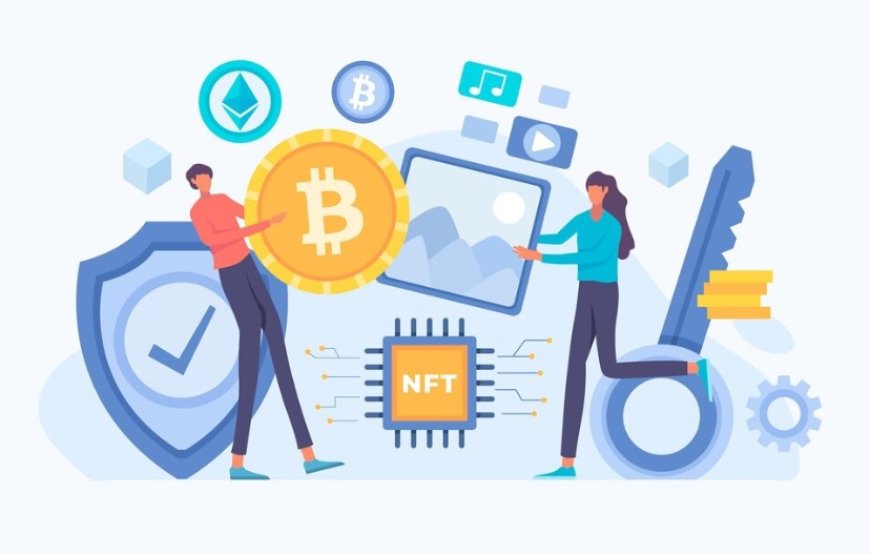Blockchain and Data Science: A Powerful Duo for Security
Explore the synergy of Blockchain and Data Science for robust security solutions. Uncover the powerful combination shaping the future of digital protection.

Blockchain is like a super-secure diary that everyone can see but no one can change once it's written. It's not owned by any one person; instead, it's spread out everywhere, making it super tough for the bad guys to mess with.
Data science is the wizard behind the curtain, working magic with numbers. Imagine it as the detective of the digital world, figuring out patterns and predicting what might happen next.
Now, why are they a dynamic duo? Well, blockchain locks up information super tight, and data science is the brain that understands and predicts what might try to break in. It's like having a super strong vault with a genius guarding the door.
So, are these two buddies together? They're the ultimate tag team, making sure your data is safe and sound, ready to take on any villainous data thieves that might come their way. Get ready for a safer digital world, thanks to blockchain and data science!
Challenges in Traditional Data Security
But, you know, there's a bit of a problem in our digital world. The way we usually keep our secrets safe is having a tough time. First off, the usual way of guarding info, like having one central spot for it, is like putting all your eggs in one basket. If that basket gets messed with, all your eggs are in trouble.
Now, imagine this: our world is crazy about using loads of data. Like, everywhere you look, someone's collecting and using data to make things work better. Sounds cool, right? But, here's the hitch – the more we use data, the trickier it gets to keep it all safe. It's like having so many cookies in the jar that it's hard to make sure none of them go missing without someone noticing.
So, it's a bit like having this old, rusty lock on a door that everyone knows about, and suddenly, there's a treasure chest full of goodies inside. The more people who know about it, the more chances someone might try to crack that lock. And guess what? That's where the trouble starts.
In our world of endless data and the not-so-strong locks, it's like a playground for those who want to sneak in and grab the goodies. That's where the rise of using data for everything is both awesome and a bit scary. The more we use data, the more we need to make sure it's locked up tight. And that's where our heroes, blockchain and data science, step in to save the day. They're like the new and improved security system for the digital treasure chest, making sure no sneaky hands can grab our digital cookies without us knowing. So, in this wild digital adventure, we need our heroes more than ever to keep our data safe and sound.
How can blockchain enhance data security?
Blockchain technology has gained widespread attention for its potential to enhance data security in various industries. At its core, a blockchain is a decentralized and distributed ledger that records transactions across a network of computers in a secure and tamper-resistant manner. The key features of blockchain that contribute to improved data security can be understood through its decentralized nature, immutability, transparency, and the use of cryptographic techniques.
One of the primary ways blockchain enhances data security is through decentralization. Traditional data storage systems often rely on a central authority or server to store and manage data. This centralized approach makes the system vulnerable to a single point of failure, where a breach or attack on the central server can compromise the entire dataset. In contrast, blockchain distributes data across a network of nodes, eliminating the need for a central authority. Each node in the network stores a copy of the entire blockchain, making it challenging for attackers to target a single point and ensuring that the data remains accessible even if some nodes are compromised.
Immutability is another critical aspect of blockchain that enhances data security. Once a block of data is added to the blockchain, it becomes nearly impossible to alter or delete that information. This is achieved through the use of cryptographic hash functions and consensus mechanisms. Each block contains a unique identifier called a hash, which is generated based on the information within the block and the hash of the previous block. Changing any information within a block would require recalculating the hash for that block and all subsequent blocks, a task that is computationally infeasible. As a result, the data stored in a blockchain is considered immutable, providing a high level of integrity and protection against unauthorized alterations.
Transparency is a key feature of blockchain that contributes to data security by providing a clear and open view of the entire transaction history. In a blockchain network, all participants have access to the same ledger, and every transaction is recorded and visible to all nodes. This transparency helps in detecting any discrepancies or suspicious activities in real-time, as any unauthorized changes to the data would be immediately apparent to the participants. This shared visibility fosters trust among users and ensures that the data remains reliable and accurate.
The use of cryptographic techniques within blockchain technology further enhances data security. Transactions in a blockchain network are secured through cryptographic algorithms that ensure the confidentiality and integrity of the data. Public and private keys are used to authenticate users and validate transactions, adding an extra layer of security. Additionally, consensus mechanisms, such as Proof of Work or Proof of Stake, play a crucial role in validating transactions and maintaining the overall security of the network.
In practical terms, blockchain's application in data security extends across various industries. For example, in the financial sector, blockchain can secure financial transactions and prevent fraud by providing a transparent and tamper-proof record of all transactions. In healthcare, patient records stored on a blockchain can be securely managed, and access can be controlled through cryptographic keys, ensuring the confidentiality of sensitive medical information. Supply chain management can benefit from blockchain by ensuring the traceability and authenticity of products, reducing the risk of counterfeit goods entering the market.
Smart contracts, self-executing contracts with the terms of the agreement directly written into code, also contribute to data security in blockchain. These contracts automate and enforce the execution of predefined rules, eliminating the need for intermediaries and reducing the risk of human error or manipulation. The use of smart contracts can streamline various processes while ensuring the security and transparency of the transactions.
Despite the promising benefits, it's important to acknowledge that blockchain technology is not a one-size-fits-all solution for data security. While it addresses certain challenges, it also poses new considerations, such as scalability, energy consumption (in the case of Proof of Work consensus), and regulatory concerns. Additionally, the human factor, such as the management of private keys and access controls, remains a critical aspect of ensuring the overall security of a blockchain system.
data science play in strengthening security measures
Data science plays a crucial role in boosting security measures in various ways. In simple terms:
-
Threat Detection and Prevention: Data science helps identify patterns and anomalies in large datasets. It can detect unusual activities that may indicate a potential security threat, enabling proactive measures to prevent breaches.
-
Machine Learning in Security: By using machine learning algorithms, data scientists can develop models that learn from past security incidents. These models can predict and mitigate future threats, enhancing overall security.
-
Fraud Detection: Data science is instrumental in developing fraud detection systems. By analyzing transaction data, it can identify suspicious patterns or behaviors, helping to prevent financial fraud and unauthorized access.
-
User Authentication: Implementing biometric data and behavioral analytics, data science enhances user authentication processes. This ensures that only authorized individuals have access to sensitive information, reducing the risk of unauthorized breaches.
-
Incident Response: In the event of a security incident, data science aids in rapid and effective response. Analyzing real-time data can help security teams understand the nature of the threat, allowing them to contain and mitigate the impact swiftly.
-
Security Analytics: Data science tools are utilized to analyze log files, network traffic, and other security-related data sources. This helps in identifying trends, vulnerabilities, and potential risks, enabling organizations to proactively address security gaps.
-
Predictive Analysis: Through predictive analytics, data scientists can forecast potential security threats based on historical data. This allows organizations to implement preemptive measures, staying one step ahead of cybercriminals.
-
Continuous Monitoring: Data science enables continuous monitoring of network activities and system logs. This constant vigilance helps in early detection of any abnormal behavior, allowing security teams to respond promptly.
-
Security Automation: Data science is used to automate routine security tasks, reducing the workload on human operators. Automation ensures a quicker response to security incidents and frees up resources for more complex threat analysis.
Data science acts as a powerful ally in fortifying security measures by providing advanced analytics, pattern recognition, and predictive capabilities that strengthen the overall resilience of systems and networks against evolving cyber threats.
The partnership between blockchain and data science promises a robust future. Blockchain's decentralized nature ensures tamper-proof data, while data science brings analytical prowess to identify and thwart threats. Together, they form a dynamic duo, reinforcing security measures. Businesses are encouraged to embrace this alliance for enhanced protection. The synergy of blockchain and data science not only safeguards against evolving risks but also instills confidence in the integrity of digital ecosystems, ushering in a more secure and resilient future for enterprises.

























































